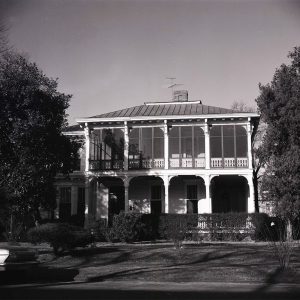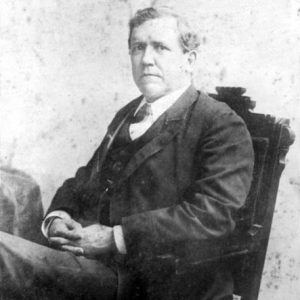calsfoundation@cals.org
Augustus Hill Garland (1832–1899)
Eleventh Governor (1874–1877)
Augustus Hill Garland was the eleventh governor of Arkansas, a member of the Confederate Congress, a U.S. senator, and attorney general of the United States. As governor of Arkansas, Garland worked to get the state out of a tremendous debt and improve the state’s image. As the subject of the U.S. Supreme Court case Ex parte Garland, Garland is also a part of legal history, and Garland County is named for him.
Augustus Garland was born on June 11, 1832, in Covington, Tennessee, to Rufus Garland and Barbara Hill Garland. He had an older brother, Rufus, and an older sister, Elizabeth. Garland’s father moved the family to Lost Prairie (Miller County), where he owned a store. He died when Garland was an infant. Barbara Garland married Thomas Hubbard in 1836, and the family relocated to Washington (Hempstead County). Garland attended school at the Spring Hill Male Academy from 1838 to 1843 before attending St. Mary’s College in Lebanon, Kentucky. He then graduated from St. Joseph’s College in Bardstown, Kentucky, in 1849.
Garland briefly taught school in Sevier County at the Brounstown School in the Mine Creek Community before returning to Washington to study law with Simon Sanders, the Hempstead County clerk. In 1853, Garland and his stepfather formed a law practice in Washington, and Garland began his career as an attorney.
On June 14, 1853, Garland married Sarah Virginia Sanders. She was from Columbus (Hempstead County) but grew up in Washington. They eventually became the parents of nine children, four of whom survived to adulthood.
The couple moved to Little Rock (Pulaski County) in June 1856, where Garland became the law partner of Ebenezer Cummins, who was formerly a law partner of Albert Pike. Over the next several years, Garland became one of the state’s most prominent attorneys and, in late 1860, was admitted to the bar of the Supreme Court of the United States. Garland was also active in local and state politics. A supporter of Whig and American Party candidates in the 1850s, he was an elector for John Bell, the nominee of the Constitutional Union Party, in the presidential election of 1860.
Garland was a Unionist, and as the sectional crises unfolded, he consistently advocated Arkansas’s continued allegiance to the United States. In 1861, Garland was elected to represent Pulaski County at the Secession Convention in Little Rock, where he opposed secession at the convention’s first session. It was only after President Abraham Lincoln issued his call to arms that Garland reluctantly chose to support secession. (That same year, he also defended Abby Guy in the Guy v. Daniel freedom suit.)
During the Civil War, Garland served in the Confederate Congress located in Richmond, Virginia. In the House of Representatives, he served on the Public Lands Committee, the Committee on Commerce and Financial Independence (also called the Finance Committee), and the Judiciary Committee. Late in 1864, he was appointed to the Confederate Senate to replace Charles Mitchel, who had died. Garland brought to the Confederate Congress his belief in constitutionalism and his faith in a strong central government. Garland returned to Arkansas in February 1865 to help facilitate the return of the state to the Union.
President Andrew Johnson pardoned Garland in July 1865, and Garland reestablished his law practice in Little Rock. His most significant case was Ex parte Garland, argued in 1865. The case centered around the fact that when the war was over, the U.S. Supreme Court changed its rules to prevent former members of the Confederate government and military from arguing cases before the Court. This change, Garland argued, was unconstitutional. On January 14, 1867, by a vote of 5-4, the Court agreed. This victory led Garland to hope that the judicial system could be used to prevent the implementation of the Reconstruction Acts that had recently been passed by Congress. To this end, he spoke before the Supreme Court to urge the justices to hear the case Mississippi v. Johnson, which challenged the constitutionality of those acts. When the Court declined to hear the case, Garland turned to the political arena in his efforts to resist Reconstruction.
A party of conservative Democrats coalesced around Garland to oppose calling a state constitutional convention. Failing in that effort, they then worked to defeat the ratification of the new (1868) Arkansas constitution. The constitution was ratified, however, and Arkansas was readmitted to the federal Union. Garland, who had been appointed to the U.S. Senate in 1867 under the state constitution of 1864, was denied his seat.
For the next several years, Garland focused on rebuilding his law practice, staying out of the public spotlight, and quietly observing the political scene. By 1872, however, with the Republican Party split into three factions, the Democrats turned to Garland for leadership. His advice was to focus on electing Democrats to the state legislature. In the governor’s race, the Democrats eventually chose to support Joseph Brooks over Elisha Baxter, both Republican candidates. After an election filled with charges and countercharges of fraud, Baxter was elected. The new legislature, with a strong Democratic component, once again considered Garland for a seat in the U.S. Senate.
By the spring of 1874, Baxter began to show that he could not be controlled by the Republican leadership of Senator Powell Clayton and his friends. As the Democrats rushed to support Baxter, the situation quickly deteriorated into the armed conflict known as the Brooks-Baxter War. Joseph Brooks found a sympathetic judge who declared that he was the real governor. Garland became one of the primary strategists for Baxter and his supporters. With the concurrence of President Ulysses S. Grant, Baxter called for the legislature to assemble. Now heavily Democratic as a result of a special election in 1873, the legislature immediately acknowledged Baxter as governor.
Shortly thereafter, an election was held to call a constitutional convention. Garland was not a delegate but served as an advisor and constitutional scholar. In October 1874, an election was held to ratify the new constitution and to elect constitutional officers under it. Garland led the Democratic Party’s successful effort toward ratification and was elected governor on their ticket.
Garland was faced with a number of problems, including a congressional investigation into the election of 1872 and constant rumors that the state was in turmoil because of “White Leagues” and secret societies that threatened violence and personal harm. The greatest problem, however, was a state debt of approximately $17 million. Garland was able to reduce that debt significantly over the next two years with help from a board of finance; this board worked to get loans that would help with expenses. Garland worked to improve the image of Arkansas through a publicity campaign that included participation in the “Cotton States” Congress in Raleigh, North Carolina, in 1875 and the Centennial Exposition in Philadelphia in 1876. He was a strong supporter of education—urging the legislature to establish schools for the blind and deaf, actively participating in the search for a new president for Arkansas Industrial University, now the University of Arkansas (UA) in Fayetteville (Washington County), and helping to establish the Branch Normal College (now the University of Arkansas at Pine Bluff) to make education more accessible to the African American population of eastern Arkansas.
In 1876, Garland was once again elected to the U.S. Senate, where he took his seat in March 1877. During his tenure there, he served on the Committee on Public Lands, the Committee on Territories, and the Judiciary Committee. He worked to bring about tariff reform, internal improvements such as the regulation of interstate commerce and a federal prison system, federal aid to education, and civil service reform.
Garland resigned from the Senate on March 9, 1885, to accept the position of United States attorney general in President Grover Cleveland’s administration, becoming the first Arkansan to serve in a cabinet position. His work included giving opinions or advice on a wide range of topics including the purchase of silver under the Bland-Allison Act, the regulation of interstate commerce, and the process for granting public lands to railroads.
Garland soon found himself embroiled in scandal. While Garland was in the Senate, he had become a stockholder in, and attorney for, the Pan-Electric Telephone Company, which was organized to form regional telephone companies using equipment developed by J. Harris Rogers. The equipment was similar to the Bell telephone, and that company soon brought suit for patent infringement. Soon after he became attorney general, Garland was asked to bring suit in the name of the United States to invalidate the Bell patent. He refused. But that summer, while Garland was in Arkansas on vacation, Solicitor General John Goode authorized the suit. Supported by President Cleveland, Garland allowed the controversy to run its course, but due to the year-long public investigation, his effectiveness in office was weakened.
When Cleveland lost the election of 1888, Garland retired from politics. He continued to live in Washington DC and resumed his legal practice before the Supreme Court. He kept in touch with his friends, writing to give them advice on all the topics of the day from labor troubles in the West, to support for the Spanish-American War. He wrote several books, including Third-Term Presidential (1896), Experience in the Supreme Court of the United States (1898), and A Treatise on the Constitution and Jurisdiction of the United States Courts (1898).
On January 26, 1899, while arguing a case before the Supreme Court, he suffered a stroke, dying a few hours later. His body was returned to Arkansas and buried in Mount Holly Cemetery in Little Rock.
For additional information:
Donovan, Timothy, Willard B. Gatewood Jr., and Jeannie M. Whayne, eds. The Governors of Arkansas: Essays in Political Biography. 2d ed. Fayetteville: University of Arkansas Press, 1995.
Schlup, Leonard. “Augustus Hill Garland: Gilded Age Democrat.” Arkansas Historical Quarterly 40 (Winter 1981): 338–346.
Watkins, Barbara Nettles. “Augustus Hill Garland, 1832–1899: Arkansas Lawyer to United States Attorney General.” PhD diss., Auburn University, 1985.
Beverly Watkins
Perryville, Arkansas










I believe that Augustus Hill Garland and I are related. Also I feel it’s time American history brings his illustrious life story to the silver screen or at least create an epic documentary. I’d be willing to contribute to the production of this over-due historic American story.
Augustus Garland as a young attorney represented the re-enslaved Abby Guy in her freedom lawsuits in two cases before the Arkansas Supreme Court. (See the Encyclopedia of Arkansas entry for Guy v. Daniel.) Although he lost the 1857 case, he won her freedom from slavery in 1861 on the eve of the Civil War. (See: Mahan, Russell. Abby Guy: Race and Slavery on Trial in an 1855 Southern Court. Santa Clara, UT: Historical Enterprises, 2017.)